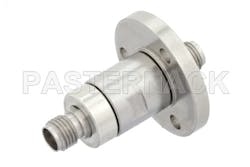Coaxial and Waveguide Rotary Joints
Rotary joints, unlike typical adapters, have the ability to rotate about the axis perpendicular to the wave propagation direction. While maintaining transmission properties, these joints can rotate freely 360 degrees. This type of joint is necessary for any application that has a rotating section, such as a rotary antenna (air surveillance), missile guidance system, and other rotating style radar applications. Without rotary joints, there would be no other way to connect rotary sections of the signal chain to fixed sections.
Rotary joints are subject to many of the same design considerations as typical adapters. Hence, insertion loss, bandwidth, VSWR, impedance, and transmission line type are all essential considerations. Given that the insertion of the rotary section leads to some additional mismatch than a high precision adapter, the insertion loss and VSWR of rotary joints tends to be somewhat higher than fixed adapters.
Rotary joints also have additional mechanical considerations associated with the rotary aspect of their operation. These additional considerations are typically expressed as a maximum rotation velocity, typically expressed as rotations-per-minute (RPM). However, there may be other considerations including mating cycles, power handling, vibration/shock tolerance, and etc. that different from standard coaxial and waveguide adapters. Moreover, there may be a side of the rotary joint that is designed as the fixed section, and another designed to be the section attached to the rotating interface.
As with other adapters, the choice between waveguide and coaxial interconnect depends largely on the requirements of the application and the interconnect used between the joints. If higher power handling and signal quality is required, waveguide are often used by default. Otherwise, for IF and low-power areas of the signal chain, coaxial interconnect is common. Moreover, waveguide joints are limited to their standard waveguide bands, while coaxial interconnect is viable from DC to a maximum frequency of operation.
While waveguide rotary joints often have rectangular or circular style interfaces, the rotary section internally is always circular by necessity. This may pose additional considerations for some applications. Coaxial rotary joints are more straightforward and function essentially the same way as a typically coaxial adapter. Hence, there are coaxial rotary joints that are in-line, between-series, PCB mount, and come in various connector sizes. As rotary joints are very often used for aircraft, avionics, aerospace, and radar applications, these components are typically made with military standard or avionics standard materials and manufacturing practices for enhanced ruggedness and reliability.
Learn more about Pasternack’s line of Coaxial Rotary Joints:
https://www.pasternack.com/nsearch.aspx?Category=Rotary+Joints&sort=y&view_type=grid
